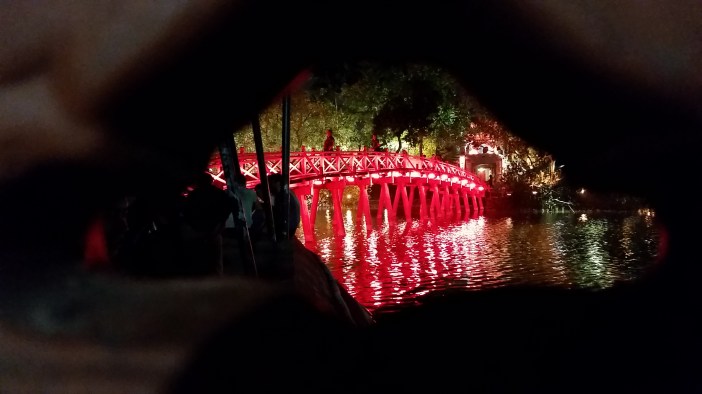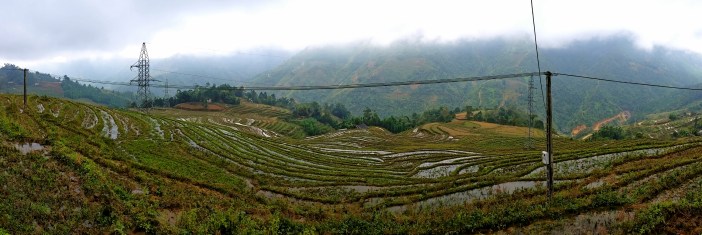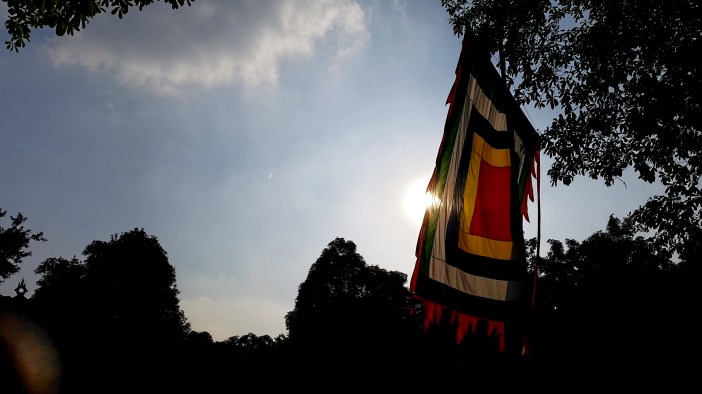Hordes of motorbikes sped by as my taxi wove through the tight streets of Hanoi, Vietnam. Signs and billboards flashed at me. Vietnamese words were scrawled across them—but at least this time, I thought, the alphabet was Romanized.
I’d been on the road for about six months, had traveled to Japan, South Korea, India, Nepal, and Myanmar. Donald Trump had just won the U.S. presidency, and I’d slept off my post-election depression and fatigue in Yangon, Myanmar, like a champ.
Here I was, another new country, another new city, another new language—starting over yet again, unsure of myself and harboring lingering doubts about having sold all my things to take this yearlong journey through Asia and maybe beyond.
I listened to the motorbikes hum and purr. The taxi entered Hanoi’s Old Quarter and pulled to a stop near my hostel. The staff was waiting to meet us. I paid the driver. I pulled my pack onto my shoulders. I took a deep breath. I started again.
*
In Hanoi’s Old Quarter, three-tiered cafes look out onto the busy streets, with locals and tourists alike sipping on cold Vietnamese coffees (strong iced coffee with condensed milk) and eyeing the passersby outside. The place hums with conversation, the crackle of caffeine, and the buzzing of motorbikes. People spill out from open-fronted restaurants, sitting on small, colorful stools in front of bowls of steaming noodles and rice bowls topped with fresh herbs and leafy greens.

Though I didn’t speak Vietnamese, I was grateful for the Romanized alphabet, the consonants and vowels that looked familiar even if I couldn’t pronounce them right. I at least could have an idea what dish a restaurant might sell (as they often specialized in just a dish or two) or could pick something off of a menu.

At each hostel and hotel I stayed at (see my recommendations below), the concierge handed me a tidy map of the area and penned in his own recommendations. Best bún chả–grilled pork and rice noodles. Best traditional puppet show—there are two around Hoan Kiem Lake, which is the centerpiece of the Old Quarter. Hanoi’s bia hơi corner—a street of local bars serving light, fresh draft beer (a.k.a., bia hơi) at about 20 cents per cup. I followed the lines like they would lead to buried treasure. I was grateful to have something so solid in my hand. To wander but know where I was going.

I slurped down the noodles and let the salty-sweet soup broth rush over my tongue. I scooped up sticky rice into my mouth with barbecued chunks of pork and washed it down Bia Hà Nội (Hanoi Beer—unsurprisingly, a beer that is ubiquitous in Hanoi). I drank thick coffee and walked around Hoan Kiem Lake. I watched the streets wind their way jaggedly off from the lake’s corners, spindly and twisting, a wild maze. But I always found my way back.
I’d thought perhaps it was a mistake. All of these new places, country after country. The way it wore me down. The way I’d only really recovered from my breakneck tour of India a couple months before.
But there was something in the frenetic hurry of Hanoi that calmed me. Maybe it was that I could read the signs and menus and felt empowered to act accordingly (instead of blindly pointing to things, as was my previous custom). Maybe it was the highly developed tourism industry that made a weary traveler feel welcome. Or maybe it was the creative buzz that pervaded the place, and the ways that the realms of the tourists and locals seemed to blend into one another—like they did in the French Quarter in New Orleans or among the numbered streets of New York. Maybe it was the way that people saw me and didn’t bat an eye—my foreignness, my gender non-conformity.

Or maybe it was Jill, my childhood friend who met with me there, who flew from the U.S. to share with me in this journey, even if only for a little over a week.
The days lightened. I began to feel refilled. I looked forward to what new things the next day would bring.

- At Hoan Kiem Lake at night
*
When Jill arrived, I introduced her to all the good things I’d found in my first two days in Hanoi—the bánh mì restaurant on the corner that sold well-spiced sandwiches on French bread that practically melted in your mouth, the light and refreshing bia hơi, the coffeeshops that gave us a chance to people watch while the motorbikes sped by. We wandered the crooked streets (and snagged a cab or two), visiting the Temple of Literature (site of Vietnam’s first university in 1076 A.D., see photos below), drinking the infamous egg coffee, finally checking out one of those water puppet shows.
We circled Hoan Kiem Lake at night. The roads around the lake had been closed off, and vendors selling neon, light-up toys shot them up into the sky and bounced them off the asphalt. Kids rode by on scooters, and musicians played tunes with lyrics I sometimes understood, their music ringing into the night.
As much as Hanoi enticed us, though, Jill and I explored the world outside of the city as well. On our first day together, we found our way to a row of travel agencies that lined the streets of the Old Quarter. We’d done our research beforehand and decided to take a tour to Halong Bay/Bai Tu Long Bay and then to Sapa with Ethnic Travel, a company that bills itself as locally owned and operated, off-the-beaten path, and socially/environmentally responsible. (It is certainly off-the-beaten path, but the rest was a little unverifiable.)
Early one morning, we hopped on one of their large vans, which picked us up at our hotel, and took the 3.5- to 4-hour drive north to Halong Bay.

As we boarded the boat at the cruise terminal, the waters glistened around us, sparkling with sunlight, and we pushed off the dock amid lines of other boats—these small and large cruise ships taking tourists on day tours or overnight cruises like ours. The famed islets and rocks of Halong Bay shot up out of the water around us, punching to the sky—a “submerged dragon” made of limestone. Hardscrabble plants clung to the islets’ sheer sides, and scrappy trees poked out from the crevices of the geological formations.

Once we got away from the crowd of other boats, we went swimming and kayaking to get a closer look. The water was a cool welcome after the heat of the sun on deck.
Up close so close in a kayak so small, the walls of rock looked monstrous but awesome, their small alcoves calling us to investigate. As we weaved our way among the rock formations, our kayaking group turned into a game of hide and seek. We disappeared around corners, into shadows. We emerged again.
Laughter pealed around us—the echoes of others on our tour.
We let the sun and water find us.

*
That night, we dropped anchor and slept with the rocking surety of the boat, the water slapping gently at its sides, squid fishermen shining bright lights off the ends of fishing boats nearby.
The next evening, though, we found ourselves on an empty beach at sunset on Quan Lan Island nearby. We stopped on the island for our second night’s rest after taking a boat ride through Bai Tu Long Bay and kayaking around oyster farms and more craggy islets. Back on solid ground, we bicycled across the flat countryside in the late afternoon sun, following our leader to this quiet spot by the sea.

And soon we were there, this empty beach, the sun setting, and something about it.
There was something about it, up to my knees in the water, deciding whether to go all the way in, deciding it was maybe warm enough, or maybe it was too cool—what did I decide? Did I go all the way in? Did I let myself soak in the chill of it?
I don’t remember.
But what I see is this: just us, just us and no one for miles. The night falling. Not knowing where we’d sleep that night—someone knew, but it wasn’t me—not knowing if it was getting too late to get there (we wended the last few curves and turns in the near-dark dark, local folks pointing us down the right way, this troupe of foreigners wobbling by on our bicycles).
But now, here, the sun was dipping lower—that’s what I saw, that’s what I remember—and it was painting the sky these brilliant colors, the way that the best sunsets do, and there I was breathing it in, alongside these others who were breathing with me, who were sharing in that beauty.
Did they know what it meant? Did they realize? How precious that breath? The gift of that moment, of the quiet. That moment together. That moment that would be so hard to recall but impossible to forget.
*
The oil was hot on my fingers later that night, the spring roll burning my tongue. I washed it down with Bia Hà Nội.
We made the spring rolls ourselves at the lodge we stayed at on the island. We took turns chopping heaps of vegetables, wearing silly, branded “Ethnic Travel” cooking caps and aprons. Jill and I laughed at the branding—it was everywhere, as we’d seen, from seat cushions to cabin curtains to the comforters on our beds.
Still, we chopped the vegetables into thin, thin pieces. And then, we took turns wetting rice paper and placing the assorted goodies on top and rolling the new creations into being. The lodge’s host fried them up for us and brought them to our dinner tables where more food awaited.
We popped open beers and drank to the day and to the night and to the good food and to the water and to the sun and to the laughter that alighted from us. We talked about the places we’d been and the ones we wanted to go to and how any of us could ever get there.
The nights were full of dreams.
*
Of course, I don’t know that this is true, or whose dreams they were, or what stories I’m leaving out. Certainly, there must be many. And there is always a before and after.
But what I’m trying to say is this: I had been living for months in multiple places. I had been reaching for a future while being dragged back to a past.
My life had quieted just enough for my mind to spill over. I had been unsure how to scoop it up. All the bits that had overflowed. That had washed over me in Pokhara or pressed down on me in Yangon.
There was a gift there, in that moment, with my old, old friend and these fellow journeyfolks.
After months on the road, perhaps it was the first time that I allowed myself to be present.
*
After our trip up to Halong Bay, Jill and I headed back to Hanoi and caught an overnight train to Sapa, where we trekked through the misty mountains near the northern border near China. Rain soaked us through to our socks, and warm fires dried us out at night. I was grateful for the fire and the warmth of our conversations and for WiFi to call our families on Thanksgiving—one morning when we woke up extra early to make sure we didn’t miss them.


Later, after Jill left, I returned to Hanoi for a few days before heading further south. I found a small studio apartment in the Old Quarter where I wrote for a few days and walked the city streets at night, visiting more cafes and eating bowls and bowls of bún riêu cua (my favorite culinary find–a tomato and crab noodle soup special to the north).
During the day, I searched for the things I would need for the rest of my month-long stay—a SIM card for my phone, a notebook to start journaling again.
At night, as darkness fell and the city began to quiet, I found that I had music in my head. I found that I could breathe.
I found that things were possible.

Travel Tips
- Hanoi’s Hostels and Hotels: There is an abundance of good, affordable places to stay in Hanoi’s old quarter. Here are the places I stayed that I’d recommend:
- Hanoi Massive Hostel: Super affordable, friendly staff, secure, great location, and you get a free beer every night (at least, that was the deal they had when I was there)
- Hanoi Capella Hotel: A beautiful, small (and affordable) boutique hotel just off of Hoan Kiem Lake and close to restaurants, cafes, and bars. Perfect location, clean and well-appointed rooms. The staff was friendly and helpful and gave great recommendations for places to eat and things to do. And the rooms were clean, bigger than I’d expected, and bright/comfy.
- Airbnb: If you’re looking for a more “local” experience or, like me, just wanted a quiet, private place to write once I’d done some traveling, Airbnb might be a good place to search for an apartment or room to rent. I stayed at a studio listed by this Airbnb host in the Old Quarter. I think she might’ve since updated the apartment (and done a lot of expanding in terms of her properties), but I had a great experience renting from her (and paid about $22USD per night and had an apartment all to myself). I think this might be the apartment post-renovation (it’s the one that loads when I click through my old reservation), but no promises. 🙂
- Eating and Drinking
- Cafes. Are. Everywhere. Find one. Order coffee like a pro. Two of my favorite cafes were Aha Cafe (multiple locations) and Old Town Cafe, famous for its egg coffee and with views overlooking Hoan Kiem Lake.
- Beer is Cheap and Delicious. Find yourself some at the bia hơi corner or order yourself a bottle or can of Bia Ha Noi at your local eatery–and get used to putting ice in your cup to keep your beer cool. There are also a few craft beer places popping up in the Old Quarter, if that suits your fancy better. Check out this extensive Hanoi beer guide to find your brew.
- Food. Is. Everywhere. And folks in the hospitality industry (i.e., hotel staff) seemed happy to recommend their favorites. Try some pho (beef and noodle soup) at the famous Phở 10 Lý Quốc Sư. Try some bún bò nam bộ (grilled beef with noodles, veggies, and a yummy sauce) at the aptly named Bún Bò Nam Bộ. It might be a hike, but you should definitely track down some bun cha (grilled pork with noodles and veg) at Bún chả 34 Hàng Than. And of course, after you’ve had your fill of bia hoi, find yourself some banh mi from the myriad of vendors and gulp that sandwich down (we tried this one and another one right across from this cafe, and both were delicious). The list literally goes on and on–spring rolls and bún riêu cua and more and more. So have a feast and don’t break the bank while doing so.
- Hanoi Social Club: On the edge of the Old Quarter, Hanoi Social Club is a local cafe and restaurant that caters to international customers and has a range of vegan and vegetarian options. This is a great place to get a coffee and get some work done–or get that brunch fix if you’ve been missing it. Food’s a little on the expensive side (compared to restaurants serving more local fare), but it’s good. As an added bonus, they’re LGBTQ-friendly and frequently host live music on nights and weekends. Just a cool place to check out in general, and a nice space for co-working.
- Hanoi Street Food Tour: Intimidated by your options? Join a food tour with Hanoi Street Food Tour, and enjoy 3 hours of a guided walk around Old Quarter eateries. For $20USD, we ate so much and learned so much about the different kinds of food the city had to offer. I highly, highly, highly recommend it. (It introduced to me to my favorite dish, bún riêu cua.)
- Touring Halong Bay/Bai Tu Long Bay and Sapa
- As mentioned, we used Ethnic Travel for our excursions to Halong Bay/Bai Tu Long Bay and Sapa. I wholeheartedly recommend the Halong Bay/Bai Tu Long Bay tour–it was one of the best parts of my travels in northern Vietnam. Reasonably priced, great food, well organized, beautiful sights, great staff. Sapa was good, too, but it was foggy and rainy and maybe a little tougher of a trek than we’d expected. But if you’re looking to get outdoors, it’s not a bad trek to take. In total, I think Jill and I paid around $300-350 each for the combined tours, which included transportation, food, lodging, and a lot of good times (beer and other treats are extra–but not expensive). Ethnic Travel’s office is easy to get to in Hanoi’s Old Quarter (35 Hang Giây Street, Hoan Kiem, Hanoi, Vietnam), and you can make reservations there or, I believe, by phone or online. (We did it in person.)
- Getting Around
- Taxis and Motorbikes: Taxis and motorbike taxis are everywhere. While I’ve read about folks getting scammed by taxi drivers in Hanoi, I had no problems. We hailed a couple taxis and made sure they had metered fare (I believe all the legit ones do), and they were totally above board. Know that many taxi drivers might not speak/read English (or your terrible accent when trying to speak Vietnamese), so it’s good to have the proper Vietnamese spelling of addresses and locations when taking a taxi (you can ask your hotel to help you out with this). Most hostels/hotels can arrange pickup for you at the airport for an additional fee (maybe like $15-20USD). Find out more about Hanoi’s taxis here.
- Grab and Uber: These two ridesharing services are now available in Hanoi. Just download the appropriate app from your phone’s app store, make sure your phone is connected to the internet, turn on your location (or write in your starting location), type in where you’re headed, and then they’ll match you with a driver. You’ll know in advance how much your ride will cost, you’ll be able to pay through the app, and you’ll have an exact map of the route your driver will (most likely) take (might vary based on traffic, etc.). Best of all, you’ll make sure your driver knows the exact address you’re going to (which will be confirmed on a map for you and the driver) without having to worry about language barriers getting in the way (and you ending up in the middle of no where). In our experience, you can even get a motorbike taxi on Uber, if you’re feeling adventurous.
- Staying Connected
- WiFi: All the hostels and hotels I stayed at throughout Hanoi had excellent WiFi. Most restaurants won’t, but you can find your fair share of cafes and coffeeshops that do.
- SIM Cards: SIM cards are readily available at from registered vendors. The two companies I saw recommended most were Viettel and Vinaphone. I bought a Vinaphone SIM card and had a fine experience throughout my travels in Vietnam. For around $5, I got 5gb of data for 30 days. Viettel and Vinaphone both have stores in/around the Old Quarter (and elsewhere). For more info on buying a SIM card, topping up, etc., check out this useful post from Too Many Adapters.







One thought on “Hanoi, Halong Bay, and Beyond: 10 Days in Northern Vietnam”